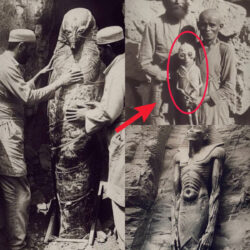
War, social unrest, pestilence, famine, and Catholic clerics agitating the population with tales of the devil and witchcraft torn apart Poland in the 17th century. Many people had demons and vampires stalking the country in their minds.
According to a recent study in the journal Antiquity (abstract), two researchers hypothesize that sickles were placed across the throats of several ancient bodies in a graveyard in Drawsko, Poland, as a deterrent to keep them in their graves. The researchers list a variety of other types of supernatural beings that Poles of the time believed in and point out that the graves were not anti-vampiric but rather anti-demonic.
The researchers, Elbieta Gajda of the Ziemi Czarnkowskiej Museum in Poland and Marek Polcyn of Lakehead University in Ontario, wrote:
The use of a sickle to enclose the corpse in the grave may have been a precaution to stop the demonized soul from endangering the living or it may have been a nod to biblical symbolism in an effort to stop the soul from becoming demonized. The latter strategy might be seen as an extension of Wittkopp’s understanding of the sickle as a “tool of God.”
We purposefully discount the idea of a revenant (i.e., vampire). Folklore holds that the soul of the dead may, as previously mentioned, be changed into a number of demons, with upi’or (commonly called a vampire) being just one of them. So, we would rather label the graves from Drawsko as “anti-demonic.” Furthermore, the Drawsko sickle interments lack any of the traits of purported “anti-vampiric practices.” They adhere to the traditional Christian burial customs; neither the cemeteries nor the deceased’s remains were desecrated. On the contrary, they were buried in sacred ground, alongside other community members who had passed away, and in accordance with tradition, showing that they had not been excluded from society.
Borzova makes a similar observation in respect to the early Middle Ages grave sickle findings from Slovakia.
The sickle has a strong symbolic history in Europe, and it is represented by the Grim Reaper and an angel announcing the judgment day in the final book of the Bible, Revelation. Both Saturn, the Roman deity of the harvest, and Ceres, the Greek goddess of agriculture, are represented by the sickle. A sickle was added to the Soviet Union’s flag somewhat later.

The angel of death is depicted on the grave of a cardinal in an Italian Catholic church.
According to Polcyn and Gajda’s writings, people could be labeled as demonic if they were outsiders to the hamlet, didn’t work as farmers but instead had other occupations, or had weird or aberrant appearances.
They came to the conclusion that these deceased individuals were locals based on the presence of strontium in their teeth. Furthermore, despite the possibility that they had other, non-skeletal abnormalities, they did not have any evident skeletal defects that may have caused their community to fear them.
A woman between the ages of 50 and 60 was buried with a coin in her mouth, a stone around her neck, and a sickle across her pelvis. Researchers came to the conclusion that she was thought to be a witch.
They speculated that a female between the ages of 14 and 19 who had a sickle across her throat, a copper headband, and a copper coin in her mouth may have died by drowning, homicide, or another means.
The sickle was visible across the throats of the other three bodies, and copper stains revealed that they had likely all had copper coins placed in or close to their mouths. Three were present: a guy, aged 35 to 44; a lady, aged 30 to 39; and a third, aged 35 to 39. The funerals otherwise followed the same protocol as every other burial in the cemetery.
In other locations in Central Europe, including Slovakia, other parts of Poland, Germany, Hungary, Lower Austria, and western Romania, archaeologists have found sickles buried in medieval and later graves.

As seen in this picture from Thebes in ancient Egypt, sclera were well-known already in the 13th century BC.
As grave goods for the wealthy or other people of high rank, a sign that the deceased was a farmer or had some other relation to agriculture, or as a military symbol, sickles have been placed on the bodies of the dead according to a number of different researchers.
According to their accounts, the dead were threatened with having their throats sliced in Drawkso by having the sickle placed across their necks. It might have also intended to keep them safe from malevolent spirits that would torture their souls.

Many ancient traditions have long regarded the sickle as a potent emblem.
According to the scholars, the Drawsko burials show that ideas incompatible with Church burial customs reappeared in the 17th century. The conflicts brought about cultural and theological regression, fanaticism, and an atmosphere of terror that Catholic clergy fueled by instilling a fear of witches and the devil. The wars also brought about starvation, pestilence, and poverty.
According to the writers, there are five different types of demons: three mythological and two human. The human sorts included live individuals who were considered to possess supernatural abilities as well as demons who were regarded to be the reincarnations of the dead.





